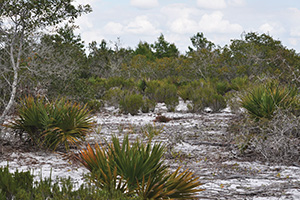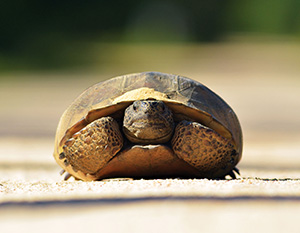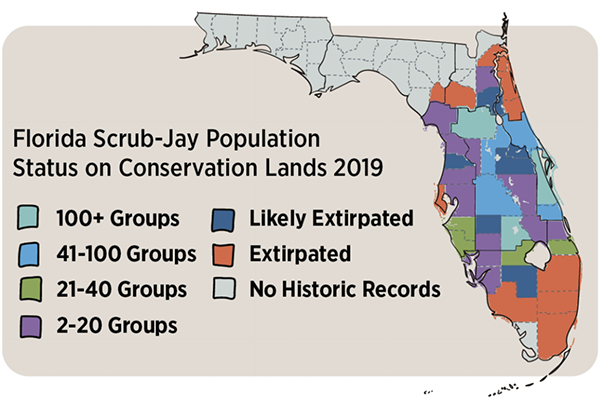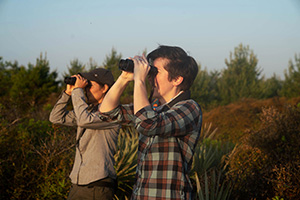
Audubon Adventures

Background for Teachers
The Florida Scrub-Jay is a rare bird for several reasons. It is also an important bird. In many ways it is the story of Florida, past and present.
Endemic to Florida
Most birds are not known for being year-round homebodies. Being able to fly means they can traverse long distances over varied terrain, crossing state, country, and even continental boundaries. Migratory birds do this on a pronounced that the birds are even reluctant to fly over non-scrub areas to reach another patch of scrub habitat.
 The Florida scrub is characterized by the dominance of several species of low-growing oak shrubs called scrub oaks, interspersed with patches of bare sand and other, often rare, shrubs like Florida rosemary, that are tolerant of regular basis. Other bird species may venture far and wide from the place they were hatched to search for mates or for better food resources. The Florida Scrub-Jay is an exception in the extreme. Not only does it never venture out of Florida—making it endemic to Florida—but it doesn’t venture beyond a few miles from its birthplace in one of the remaining patches of scrub habitat in the state. Florida Scrub-Jays’ dependence on the Florida scrub habitat is so nutrient-poor, sandy soil. Scrub palmetto also thrives in this habitat. There are few grasses and few tall trees—mostly sand pines and longleaf pines.
The Florida scrub is characterized by the dominance of several species of low-growing oak shrubs called scrub oaks, interspersed with patches of bare sand and other, often rare, shrubs like Florida rosemary, that are tolerant of regular basis. Other bird species may venture far and wide from the place they were hatched to search for mates or for better food resources. The Florida Scrub-Jay is an exception in the extreme. Not only does it never venture out of Florida—making it endemic to Florida—but it doesn’t venture beyond a few miles from its birthplace in one of the remaining patches of scrub habitat in the state. Florida Scrub-Jays’ dependence on the Florida scrub habitat is so nutrient-poor, sandy soil. Scrub palmetto also thrives in this habitat. There are few grasses and few tall trees—mostly sand pines and longleaf pines.
 Besides Florida Scrub-Jays, the sandy scrub is home to other iconic Florida animals. The burrows of gopher tortoises are also home to eastern indigo snakes, gopher frogs, Florida mice, and scarab beetles. The bluetail mole skink is also found in the scrub. It is another endemic species, found only in interior central Florida.
Besides Florida Scrub-Jays, the sandy scrub is home to other iconic Florida animals. The burrows of gopher tortoises are also home to eastern indigo snakes, gopher frogs, Florida mice, and scarab beetles. The bluetail mole skink is also found in the scrub. It is another endemic species, found only in interior central Florida.
Cooperative Breeder
The Florida Scrub-Jay is one of the rare birds that engages in cooperative breeding. Young adults hang around the family after leaving the nest, often because there are no mates available nearby or because there is no unoccupied habitat for young males to set up their own territories with a new mate. Sometimes as many as six family members from previous breeding seasons help tend their newly hatched younger siblings, bringing food and guarding the nest against predators. Researchers estimate that only about 300 species worldwide—about 3 percent of all bird species—engage in cooperative breeding. It is even rare among scrub-jays. There are other species in the scrub-jay family, but the Florida Scrub-Jay is the only one that exhibits this type of cooperative family-based behavior.
Families also forage for food together, with one assigned the role of sentinel, on the lookout for dangers from above and on the ground and sounding a warning call when a potential threat is spotted. The warning call is different if the predator is in flight versus a predator on the ground so the foragers know whether to take cover on the ground from a hawk or an owl flying overhead or to fly up into shrubs to escape a snake or other predator on the ground.
Stocking the Sandy Pantry
Florida Scrub-Jays eat a varied diet throughout the year. Caterpillars are important for their protein value to nestlings and because they are soft and easily digestible. Insects, spiders, lizards, small snakes, frogs, and even mice are consumed whenever they are available. In fall and winter, when those critters are less abundant, the scrub-jays turn to acorns for nutrition. The fact that there are many more acorns available than the birds can consume doesn’t mean they go to waste. Florida Scrub-Jays collect and bury acorns in the sand for later consumption. This is called “caching.” The birds remember where their caches are and check on them from time to time. If the cached acorns show signs of being damaged by moisture, the scrub-jay proprietor will move them to another location. A single bird stashes thousands of acorns every year. Jays are very protective of their caches and are on alert for jays in other families that may see where they buried several acorns. If a jay thinks a cache has been compromised, it will dig up the acorns and move them elsewhere to thwart acorn-robbing jays.
Trouble in the Scrub
The Florida Scrub-Jay is considered a habitat-quality indicator species. The health of the population of Florida Scrub-Jays throughout the state is an indication of the health of their habitat. Scrub patches that have larger family groups and several juveniles successfully fledged each year indicate higher quality habitat that is low and open in structure with plenty of bare sand patches and good visibility against predators. The population has been declining steadily and sharply—90 percent since the early 1800s. From a high of 40,000 individual birds, the population has dropped to an estimated 3,500 family groups or 6,000 to 8,000 individuals spread out among large and small patches of scrub habitat in Florida. The Florida Scrub-Jay is no longer found in some areas it historically inhabited, in many cases because the scrub habitat has disappeared. When the scrub disappears, the Florida Scrub-Jay disappears. It is listed as a threatened species under the Endangered Species Act.

The Florida scrub depends on regular fire to persist. This means that land management by Indigenous People, as well as naturally occurring lightning-caused fires historically prevented the scrub from becoming dense and tall and losing its open sand patches. Fires burn back pine trees that, left unchecked, could grow into a forest—an unsuitable habitat for Florida Scrub-Jays. Fire also controls the growth of grasses and other plants not native to the scrub and keeps the scrub oaks from growing so tall that it hides predators from view by the jays. Some native plants even require fire to set seeds and reproduce. Rather than using fire to maintain scrub and other fire dependent habitats, the practice over recent decades has been to prevent fires in the interest of protecting the surrounding human-built environment. Demand for new homes, roads, and businesses has grown exponentially, at the expense of the scrub and other native, fire-dependent habitats. Agriculture, especially citrus groves that grow best on well-drained, sandy soil, has eliminated large tracts of scrub across central Florida.
 The value of Florida’s unique scrub is now recognized. Increasingly, prescribed fires are being used to prevent scrub oaks from becoming dense and tall and reduce the risk of wildfires spreading to adjacent residential and commercial areas. Habitat managers carefully monitor the population and annual breeding success of Florida Scrub-Jays, which indicates the overall health of the scrub and its other resident animals and plants. When jay families begin moving out of overgrown habitat and juvenile birds can’t survive due to predation, prescribed fires are set and carefully controlled by experienced firefighters to prevent spread to nearby areas where property and human lives could be at risk.
The value of Florida’s unique scrub is now recognized. Increasingly, prescribed fires are being used to prevent scrub oaks from becoming dense and tall and reduce the risk of wildfires spreading to adjacent residential and commercial areas. Habitat managers carefully monitor the population and annual breeding success of Florida Scrub-Jays, which indicates the overall health of the scrub and its other resident animals and plants. When jay families begin moving out of overgrown habitat and juvenile birds can’t survive due to predation, prescribed fires are set and carefully controlled by experienced firefighters to prevent spread to nearby areas where property and human lives could be at risk.
Jay Watch is a community science project of Audubon Florida. Scientists train volunteers to conduct field surveys of Florida Scrub-Jay populations in 19 Florida counties. They monitor the number of adults in each family group together with the number of juveniles as a measure of annual nesting success, and also help land managers maintain the habitat. Their work and the work of scrub managers has slowed the loss of habitat and decline of scrub-jay populations throughout the state, and has increased the population at some of the larger parks and preserves.
Photos: (t to b) Carlton Ward Jr.; Marianne Korosy/Audubon; cturtletrax/iStock; map created by Frances Roy Agency; Carlton Ward Jr.




